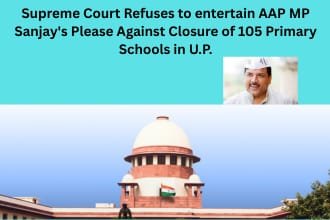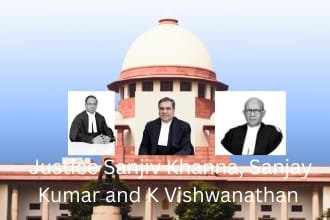New Delhi, August 18, 2025: The Supreme Court on Monday declined to entertain a writ petition filed by Aam Aadmi Party (AAP) Rajya Sabha MP Sanjay Singh challenging the Uttar Pradesh Government’s decision to close down 105 government-run primary schools across the State.
A Bench comprising Justice Dipankar Datta and Justice A.G. Masih dismissed the plea as withdrawn, noting that the matter is already sub judice before the Allahabad High Court. The apex court made it clear that since the issue is pending before the jurisdictional High Court, there was no reason to entertain a petition under Article 32 of the Constitution.
Background of the Case
On June 16, 2025, followed by a subsequent order dated June 24, 2025, the Uttar Pradesh Government resolved to shut down 105 primary schools across several districts. The State justified this move on the basis that the schools in question had either zero enrollment or negligible student strength.
The Government further stated that the schools would not be permanently abolished but “paired” with proximate institutions, ensuring that students could continue their education without disruption. This restructuring, the State contended, was in line with the National Education Policy (NEP) 2020, which emphasizes consolidation of resources for better learning outcomes.
However, Singh’s petition argued that the closure amounted to a denial of educational access, particularly for children from marginalized communities, and was therefore unconstitutional.
Petitioner’s Arguments
Singh, represented by Advocate-on-Record Sriram Parakkat, invoked Article 32 of the Constitution, alleging that the State’s decision was:
- Arbitrary and unconstitutional;
- In violation of Article 21A (Right to Education);
- Contrary to provisions of the Right of Children to Free and Compulsory Education Act, 2009 (RTE Act).
The petition highlighted Rule 4(1)(a) of the RTE Rules, which mandates the establishment of a primary school within a one-kilometre radius of every habitation having a population of at least 300. According to Singh, the closure of these schools would particularly affect children between 6–11 years of age, especially those belonging to Scheduled Castes, Scheduled Tribes, minority communities, and girls, who face additional logistical and safety barriers.
It was contended that:
- Parents are withdrawing children due to safety and transportation concerns, leading to a de facto denial of education;
- The move risks pushing children into child labour or domestic work;
- The decision was taken without consulting School Management Committees (SMCs) as mandated under the RTE Act;
- An executive instruction cannot override statutory mandates, and therefore, the State’s action is ultra vires the statute.
Respondent’s Stand
The Uttar Pradesh Government, represented by Advocate-on-Record Ankit Geol, justified the closures on grounds of policy restructuring and educational efficiency. It argued that maintaining schools with negligible or no students was unsustainable, and pairing them with nearby schools would help consolidate resources and improve teaching quality.
The State also pointed out that this restructuring was in alignment with NEP 2020, which envisions larger and more resourceful school complexes.
Legal Context
At the heart of the dispute lies the interplay between Article 21A of the Constitution and the Right to Education Act, 2009.
- Article 21A guarantees the right to free and compulsory education for all children between the ages of 6 and 14.
- Section 6 of the RTE Act, read with Rule 4(1)(a) of the RTE Rules, obligates States to establish primary schools within specified neighborhood limits.
Singh argued that once established, these schools cannot be arbitrarily shut down or merged through executive fiat without legislative authority or alternative arrangements ensuring accessibility.
The case also raises questions about judicial federalism—whether such disputes should first be addressed by High Courts before being escalated to the Supreme Court. The Bench’s refusal to entertain the petition underscores the principle that localised disputes with statutory implications are best adjudicated initially at the High Court level.
Implications of the Decision
Although the Supreme Court has not adjudicated on merits, the matter highlights significant issues:
- Access to Education: The closure of schools, even if justified on efficiency grounds, raises concerns about accessibility for children in rural and marginalized communities. Distance, safety, and socio-economic barriers could undermine the constitutional promise of universal education.
- Policy vs. Statutory Mandates: While NEP 2020 encourages consolidation, statutory mandates under the RTE Act continue to emphasize neighborhood schools. Any restructuring must therefore reconcile national policy with binding legal obligations.
- Role of School Management Committees (SMCs): The alleged bypassing of SMCs in the decision-making process raises procedural concerns. SMCs are designed to ensure community participation in school governance, and their exclusion could undermine accountability.
- Judicial Pathway: By redirecting the matter to the Allahabad High Court, the Supreme Court has effectively placed the responsibility on the State’s jurisdictional judiciary to balance constitutional guarantees with administrative policy.
Possible Outcomes
The pending proceedings before the Allahabad High Court will be crucial in determining the fate of the affected schools. The High Court may consider:
- Whether the State’s decision violates the constitutional right to education;
- If adequate alternative arrangements have been made within statutory neighborhood limits;
- Whether the decision was taken with procedural fairness, including consultation with stakeholders;
- The extent to which NEP 2020 can justify deviation from RTE requirements.
If the High Court finds the closures arbitrary or contrary to law, it may direct the State to reopen schools or devise alternative mechanisms ensuring compliance with the RTE framework. Conversely, if it upholds the State’s stand, the matter could eventually return to the Supreme Court through a special leave petition.
Conclusion
The Supreme Court’s refusal to entertain Sanjay Singh’s petition does not close the door on the issue but redirects the battle to the Allahabad High Court. The case underscores the tension between policy-driven reforms and statutory obligations, as well as the enduring challenge of ensuring that India’s most vulnerable children do not lose access to their fundamental right to education.
The outcome before the High Court is likely to set a precedent for how States balance school consolidation policies with the RTE Act’s neighborhood school mandate, making it a case of national importance for education law and governance.
Also Read



